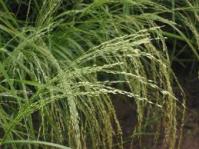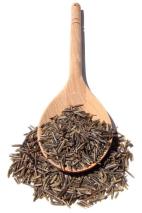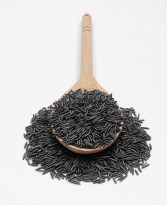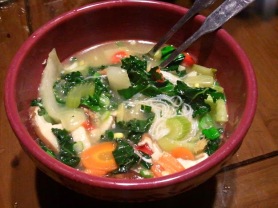I put off reintroducing non-Whole30-approved foods for several extra days, in effect making a Whole40 instead. Mostly this is because I managed to get a nasty cough that persisted for the last three weeks, and The Farmboy got a cold the week we were supposed to start reintroducing stuff, too. We thought that it would be hard to tell if new foods made us feel crappy, because we already felt crappy. By the way, this meant we stayed on the the Whole30 through 3 Christmas meals with friends and family and two New Years gatherings! And it didn’t even hurt! Woo-hoo!
Yesterday (Day 41) we felt like it was time to “take off the training wheels”. So we stared our day off with scrambled eggs, homemade kimchi, and sourdough teff-flour pancakes with apples slices and ghee. It was pretty yummy! And teff is an ancient cereal grass, with an attractive nutrient profile (for a grain) similar to millet and amaranth. Unfortunately, I was surprised that I already started to feel some mild inflammation before I had my lunch.
Lunch was brussels sprouts, red peppers, and patty pan squash sauteed in ghee, with pastured-pork chorizo. I added about half a cup of wild rice cooked in bone broth that my friend had harvested this fall, and it was so incredibly delicious. Wild rice is an all-time favorite food, subtle and nutty and fast-cooking.
For those who don’t know, there is a huge difference between commercially grown wild rice and the real stuff, taste-wise and also in cultural impact. True wild rice is actually the seed of an aquatic grass- that means it grows in lakes! It is hand-harvested, usually by shaking the stalks over a canoe. The commercial stuff is more like rice, is often grown with chemical and on paddies that artificially flooded, and then mechanically harvested. Right now, there is a lot of controversy surrounding wild rice, as mining practices threaten to make it extinct. Wild rice, or manoomin, is a sacred and traditional food to the indigenous people of Minnesota and Wisconsin (the Anishinaabe or Ojibwe people), and there are lots of people fighting to protect the manoomin. Buying native-harvested wild rice can support these efforts to preserve Anishinaabe culture and food. You can also get it here and here.
At the next meal, I was lucky enough to be fed a decadent bowl of chicken soup. It was different than the soup I talked about in my last post– this one was made with bone broth, yes, but flavored with scallions, ginger, shiitake mushrooms, red peppers, and lime, with plenty of dark leafy greens. The Farmboy added white rice noodles, which are fun to eat, but honestly the soup would have been just as good without them. Other than the highlighted grain-containing foods, I ate a clean Whole-30 diet all day, with no snacking between meals.
How did it go? Well, I ate only Whole-30 approved foods all day today (Day 42), but I feel some mild effects of the grains. I had a hard time waking up this morning. I had some mild achiness in the joints in my hands and arms. I also felt weirdly “off” before lunch, and I realized I was having low blood sugar. Then it occurred to me that I hadn’t had low blood sugar (with the off-center, distracted, jittery fog it comes with) in several weeks! I think grains 3 meals/day is out after this experiment, for sure. Rice noodles were so not worth it (and the most likely culprit, in my opinion, for my crazy blood sugar fluctuation). I’d rather have the occasional Paleo pancake than risk that blood sugar yuckiness for a sourdough teff pancake. Wild rice, however, is going to make an occasional appearance in my diet in the future. Hopefully, in small amounts and on days when I eat an otherwise Paleo diet.



